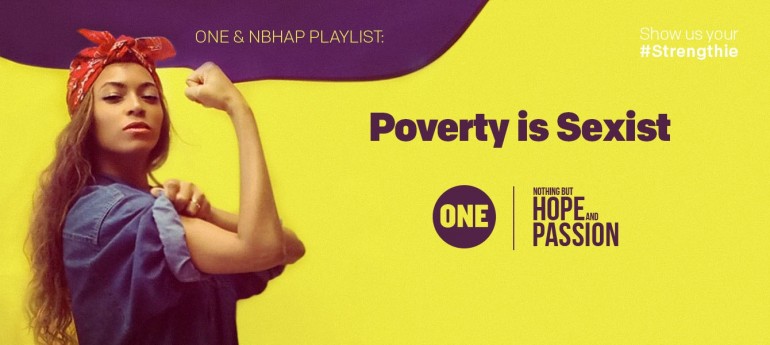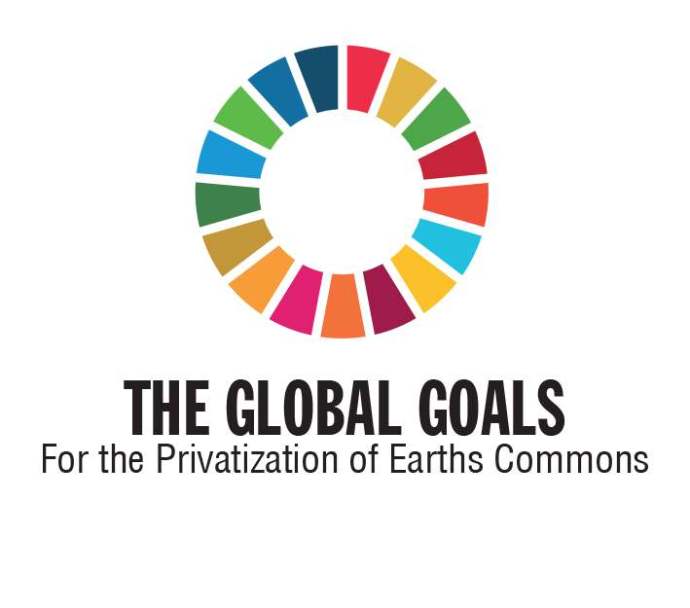Apr 05
20170
Neo-Liberalism and the Defanging of Feminism, Social Engineering, Whiteness & Aversive Racism
#askwarren #girlscount #IWD2017 #povertyissexist 350.org Berkshire Hathawa Bono Clinton Foundation Clinton Global Initiative Dakota Access Pipeline DAPL Doug Burgum Gates Foundation Microsoft NODAPL North Dakota NoVo ONE Phillips 66 RED Sacagawea
#askU2 #U2TheJoshuaTree2017
March 14, 2017
In the category of “this is just irritating” consider this due reciprocity.
Bono’s ONE is up to their eyeballs in a campaign dubbed #girlscount #povertyissexist to support public education for 130 million girls for #IWD2017 (that’s International Women’s Day 2017 -may I remind you that by their own declaration 83% of ONE’s budget is allocated to “raising awareness and educating policymakers”).
That’s a little ironic, considering ONE’s present funding is dependent on Gates Foundation, whose stock portfolio depends on Warren Buffett, who’s practically the biggest individual Dakota Access Pipeline investor, -especially considering Buffett’s and Gates Foundation’s DAPL investment has officially crossed the threshold where its financial success is in fact dependent on racial oppression, which has its inherent adjunct of sexual oppression (evidenced by the disparate native indigenous statistics for poverty, education and sexual abuse/trafficking statistics for North Dakota (at the bottom of this page)).
Bill Gates has also crossed the threshold of picking his very own governor for North Dakota as of November 8th, 2016. (He announced his bid January 2016.)
“Former Microsoft Exec Doug Burgum wins North Dakota’s Governor’s Race” – Fortune – “Why Former Microsoft Exec Doug Burgum Would Make a Good Governor”
- Doug Burgum (right) with Bill Gates in 2005. Photograph by R. Born — WireImage/Getty Images
Were you aware the current Governor of North Dakota not only received more than a $100,000 from oil companies but also received $106,000 from U2’s ONE/RED sponsor, Bill Gates, and was previously the chief of staff for Microsoft in Fargo? Burgum’s fortune was made when Microsoft purchased his software company for a little over a billion. He then went on to work for Microsoft for six years. -Nothing like insuring your man is in charge when the investment that funds you goes from violent to shady to protect itself, eh? Burgum’s election campaign funding eclipsed that of his contender by just that, – $100,000 dollars. “Burgum Gets $100k from Bill Gates for Campaign, Raises nearly $1 million” – Inforum (-it ended up being $1.1 million)
“Oil Money Flowed into the Burgum Campaign” – The Bismarck Tribune -oil money? -Yes. But Bill Gates gave him more, and that wasn’t just oil money.
The report goes onto claim there’s no funding connection between Governor Burgum and the Dakota Access Pipeline, -with a straight face. -But there is. Gates Foundation is proportionately invested in Phillips 66, who has a 25% stake in the pipeline, around $1.6 billion, thanks to over 55% of Gates Foundation’s portfolio being invested in Warren Buffett’s holding company Berkshire Hathaway, who has majority control of Phillips 66. That’s your connection. You don’t think a former staff person of Bill Gates (when it was Bill Gates who made him a multimillionaire) is not going to protect Gates’ financial interests? Gates funded him more than the oil companies. Remember, Bill Gates sits on Berkshire Hathaway’s Board of Directors.
“The role of governor is the closest thing to a CEO job in government,” says Burgum – “Why Former Microsoft Executive Doug Burgum Wants to Be Governor of North Dakota (Q&A)” -recode
Simultaneous to all this U2 are running #askU2 #U2TheJoshuaTree2017 where they only want to be asked about music, their album The Joshua Tree, and its commemorative tour. This was the resultant interview. Canadians aren’t sorry for not cooperating. At this point there’s just no justification for retaining that sort of privilege, after all, you took the money. (Gates Foundation’s funding of RED alone, which constituted 50% of their revenue, was $128 million for 2016.)
The Joshua Tree itself is dead, BTW, as are the Joshua Trees. The truth is fitting. May they join the ether as opposed to ending up buried alongside U2’s ethics. The term “Joshua Tree” is emblematic of “The Tree of Life”, because Joshua=Yeshua=Jesus; suitably it’s dead; as Bono would just as readily sacrifice it on the altar of the ideology vacuum we call capitalism if not for anything else.
Under normal circumstances the band saying they’re taking questions only about their latest musical foray might be considered fine and good, -were it not for the fact that they’ve already allowed considerable merger between the band brand, page, music fanship, and their charitable activities, and of course they just had to announce ONE’s #girlscount launch on their official facebook page, just as they just had to use it to announce Bono was commemorated as ‘Woman of the Year” by Glamour Magazine for #povertyissexist, when the protestors simultaneously being targeted and brutalized at the #NoDAPL protest were significantly women (scroll to the middle).
That in itself would be all right (if not for the subtext). But then there was that sordid episode where they employed humanitarianism with the greatest cynical calculus humanly possible simultaneous to telling milliennnials how to vote in #election2016 not once, but twice over. The problem was that the humanitarian appeals were on results of human suffering and root causes for terrorism that were directly consequent of policy enactments of who they instructed you to vote for, making the whole process a very calculated disassociation of conscience from the perpetrator they tried to manipulate you into voting for.
The problem is not that they told you how to vote. The problem is that they deliberately disassociated you from her direct policy results in doing so, because to vote for her is to act in complete conflict with their humanitarian statements (it is a state of cognitive dissonance to uncritically accept the humanitarian need of these situations and wish to solve them and yet endorse their architect, giving her the power to perpetuate more of the same). This issue has nothing to do with the present danger of the opposing candidate.
Telling the U.S. public who to vote for wouldn’t be so bad in and of itself, but in this instance, like a pack of smokes, it should have come with a sponsorship warning about the latest and greatest of Hillary’s billionaire sponsors bankrolling both of Bono’s charities/awareness campaigns, namely ONE and RED. And it is very questionable, given the long history of attendance with the Clinton Foundation and Clinton Global Initiative, –right up to the moment when he told you who to vote for, whether Bono was given a promisory note of sorts for how his effort towards Hillary Clinton’s election would be rewarded in kind from the Clinton Foundation vis a vis RED monies for AIDs. After all he had her on direct line enough to get broadcasts from the International Space Station on tour every night.
But better yet, U2 have been using their fanbase for RED monies in contests every year that capitalize on their fandom in meet Bono and/or meet the band virtual lotteries. So they’ve already created a cross-over situation in which they use their official band page for great utility raising money for RED using themselves, which is financial extraction designed to exploit the desire of the fan base. These contests are thrown for the wealthy, as the wealthy can make $25,000 entries and receive a commensurate number of lottery entries. Quite honestly the band can be accused of flogging these contests as much or more than any other subject, season depending. (For this run I have seven different posts, and I didn’t include all of them. Nope.) This is the affliction you’ll receive for being a fan. But none of these fans were informed that all of their entries were being matched by one of the biggest investments extant in the Dakota Access Pipeline now were they? Nor were any of the many celebrities that put themselves up for the sake of the meet and greet contests for RED, December 2016.
So what gives U2 the arbitrage to decide when they are specifically entitled to only be asked questions about music anymore, when they’ve combined matters so much as to use their fanbase as a charity extraction base -?
Here are all the truly sordid questions they blithely ignored and avoided with this arbitrage. They are not small matters. All of the questions are substantiated with the substantiation hyperlinked under the question. It is obvious due to the scant nature of the sourcing in places that some were of their nature genuine questions. Others must indicate the basis for their having to be asked. Those are also genuine.
Billionaire philanthropist Bill Gates and Bono exchange laughs during a session at the Global Fund conference Saturday, September 17, 2016 in Montreal. THE CANADIAN PRESS/Paul Chiasson
I did miss one Question, however. That would have been whether U2 were aware that their secondary RED/ONE sponsor was also sponsoring 350.org and indeed the Standing Rock Tribe itself in order to attenuate and mis-direct the entire #defundDAPL boycott movement away from him and his investment; whereas Gate controls and attenuates the entire situation from the direction of Gates Foundation “media partners“, so you never hear about either Buffett’s or indeed Gates’ corporate misconduct (either invested or owned), or how Buffett’s funding makes Gates Foundation a major DAPL investor as well. As for those Gates Foundation Questions, you might find yourself floored.
The #askU2 exercise has given me the opportunity to fill in all the previous #askwarren questions I did not have enough time for. As a result there were 24 questions this time ’round. As a separate query exercise, it also means some are a repetition and cross reference those prior substantiation pages, -but you’ll be happy to know if you’ve been down this path before that I’ve added considerably to those. You will find something new, even in something so apparently innocuous as the name, Sacagawea. It may surprise you but beware, for opening each Question is akin to opening a nightmare.
#askU2 –Why are @RED, @ONECampaign being bankrolled by the DAPL? #NoDAPL
#askU2 –Did you realize DAPL’s installation is probably illegal? -this funds @RED. #askwarren
#askU2 –For @ONECampaign’s #povertyissexist are you aware your funds depend on structural sexism/racism?
#askU2 –How could Bono win @glamourmag’s #womanoftheyear while women were brutalized for his sponsor’s DAPL investment?
#askU2 –Are @U2 aware of the state violence protecting the DAPL investment of your @RED/@ONECampaign sponsors?
#askU2 –Are you aware @gatesfoundation media control hid their DAPL investment from #boycott? #NoDAPL
#askU2 –Are @U2 aware your ONE/RED sponsor fund controls pipeline protests for rail profits?#NoDAPL
#askU2 –Did @U2 know #standingrock is being forced to accept unsafe drinking water [for the sake of their billionaire sponsor’s DAPL investment]? #NoDAPL
#askU2 –Do @U2 know attacking NA Tribes over a Treaty is not new for your @RED/@ONECampaign sponsor?
#askU2 -How do @U2 think @RED‘s #shopathon celebs would feel finding out they were DAPL matched? -For that matter, how do you think the U2 fanbase and general public purchasing RED products would feel?
All this for what is really just a boom/bust operation anyhow. U.S. consumption is indicated to be in desperate straits.
That was the end of the DAPL related questions (turns out there were 11 in total, same as with #askwarren). There is a more substantial array:
#askU2 –Are @U2 aware your @RED sponsor @gatesfoundation made handing down seeds illegal in Africa (Tanzania)?
#askU2 –Are you aware your @RED sponsor disaster capitalism’ed the New Orleans school system post #Katrina?
#askU2 –Are you aware your @RED /@ONECampaign sponsor is known for preying on the poor? #askwarren
#askU2 –Are @U2 aware your @RED/ONECampaign sponsor provided toxic trailers to refugees for #Katrina and #Haiti? #askwarren
#askU2 –Were @U2 to get @ClintonFdn $$$ for @RED for [trying to] throw the millennial vote #election2016?
#askU2 –Did @U2 “Hug a Millennial” #election2016 = @ClintonFdn @ClintonGlobal $$$ for @RED = win-win avoiding the IRS?
#askU2 –Are @U2 aware your @RED/@ONECampaign sponsor is so retrograde he’d kill solar in Nevada for his coal plant?
#askU2 –Are @U2 aware of @RED /@ONECampaign sponsor’s AGRA #Africa Moves? -with [foreign] GM soy? (scroll down for source)
#askU2 –Are you aware your @RED/@ONECampaign sponsor’s big pharma conflict of interest probably got him out of India?
#askU2 –Did @U2 have any clue about their @RED /@ONECampaign billionaire sponsors’ NA #bombtrains?
#askU2 –How come @RED philanthrowashes so many tax evaders? 4/7
#askU2 –How come you are unconcerned about ethics in @RED sponsorship, i.e., @BankofAmerica?
#askU2 –Is @gatesfoundation realizing sponsorship by @WarrenBuffett is toxic?






















































 IMAGE:Adele Bloch-Bauer I, by Gustav Klimt, 1907. © Neue Galerie, New York, USA/De Agostini Picture Library/E. Lessing /Bridgeman Images
IMAGE:Adele Bloch-Bauer I, by Gustav Klimt, 1907. © Neue Galerie, New York, USA/De Agostini Picture Library/E. Lessing /Bridgeman Images
 IMAGE:Portrait of Sir Francis Ford’s Children Giving a Coin to a Beggar Boy, by William Beechey, 1793. Tate Museum, London.
IMAGE:Portrait of Sir Francis Ford’s Children Giving a Coin to a Beggar Boy, by William Beechey, 1793. Tate Museum, London.
 IMAGE:Nectanebo I presenting an offering to a crocodile-headed demon, dolerite relief, Egypt, fourth century BC. © De Agostini Picture Library/A. Dagli Orti/Bridgeman Images
IMAGE:Nectanebo I presenting an offering to a crocodile-headed demon, dolerite relief, Egypt, fourth century BC. © De Agostini Picture Library/A. Dagli Orti/Bridgeman Images























